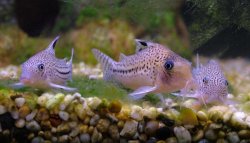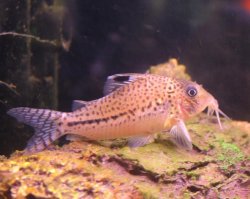My more reclusive catfish has finally come to the front of the tank with its mates, after two and a half weeks of sulking in the back. Now that it has, I am wondering whether it is actually a Julii....as you can see from the photo I took this afternoon, it does look rather different. Apart from the fact that it is a bit larger, it doesn't have spots on its face and has a kind of brown "up and over" mask, from one eye to the other. I am wondering whether it might simply be an older fish, or perhaps a "cross" with something else.
You are using an out of date browser. It may not display this or other websites correctly.
You should upgrade or use an alternative browser.
You should upgrade or use an alternative browser.
The December FOTM Contest Poll is open!

🏆 Click to vote! 🏆
There are a few options for what your other cory is but it certainly is not a julii
Possible identities include, Spotted Back Corydoras, Corydoras melanistus or Corydoras brevirostris.
Possible identities include, Spotted Back Corydoras, Corydoras melanistus or Corydoras brevirostris.
have a look at these
http /www.planetcatfish.com/common/species.php?species_id=380
/www.planetcatfish.com/common/species.php?species_id=380
http /www.planetcatfish.com/common/species.php?species_id=1540
/www.planetcatfish.com/common/species.php?species_id=1540
http /www.planetcatfish.com/common/species.php?species_id=852
/www.planetcatfish.com/common/species.php?species_id=852
There are loads more 'spotty' cories on there so maybe pop over and have a look
http
 /www.planetcatfish.com/common/species.php?species_id=380
/www.planetcatfish.com/common/species.php?species_id=380http
 /www.planetcatfish.com/common/species.php?species_id=1540
/www.planetcatfish.com/common/species.php?species_id=1540http
 /www.planetcatfish.com/common/species.php?species_id=852
/www.planetcatfish.com/common/species.php?species_id=852There are loads more 'spotty' cories on there so maybe pop over and have a look
I would venture that none of the three fish in your photo is C. julii. Beyond that, the first link (C. acrensis) in Akasha's post is possible, but I would tend to suspect the species is more likely to be C. trilineatus, here is PC's page on this species:
http /www.planetcatfish.com/common/species.php?species_id=508
/www.planetcatfish.com/common/species.php?species_id=508
There are several very similar species, and to make matters more difficult, there is considerable variation within each species with reference to the spotted pattern and the lateral line. C. trilineatus is almost always the true species when a store says "julii" but that obviously cannot be guaranteed.
Byron.
http
 /www.planetcatfish.com/common/species.php?species_id=508
/www.planetcatfish.com/common/species.php?species_id=508There are several very similar species, and to make matters more difficult, there is considerable variation within each species with reference to the spotted pattern and the lateral line. C. trilineatus is almost always the true species when a store says "julii" but that obviously cannot be guaranteed.
Byron.
Just visited those links.....good grief, I didnt know there were so many! I'm still working through the "B's"! It's almost as bad as identifying moths. Byron, thank you, the trilineatus is the one I looked at when I got the fish home and I did mentally query the julii ID when I read about how similar the species were. This long snout has me thinking it has a face a bit like C. acutus....but then again it might be something else. It was a good opportunity to get em all in the photo-frame, for once.
there are hundreds of different type of cory and more are being discovered all the time. My melini cories are one of those that looks similar to many others - metae's being the main one that jumps into my head.
You could pass several hours on PC looking at all the different cories - enjoy lol
You could pass several hours on PC looking at all the different cories - enjoy lol
Wait, those aren't Juliis? My catfish look like that, and I always assumed that they were julii, because that is what they were called at the fish store. Now that I think about it, I realize that what the fish store said they were doesn't mean a whole lot.
Edit: Looking on that website you posted a link to, Akasha, and my catfish look like a lot of the varieties. Its really hard to tell the difference, I guess I just need to look at fish more!
Edit: Looking on that website you posted a link to, Akasha, and my catfish look like a lot of the varieties. Its really hard to tell the difference, I guess I just need to look at fish more!
Blough said:Wait, those aren't Juliis? My catfish look like that, and I always assumed that they were julii, because that is what they were called at the fish store. Now that I think about it, I realize that what the fish store said they were doesn't mean a whole lot.
Edit: Looking on that website you posted a link to, Akasha, and my catfish look like a lot of the varieties. Its really hard to tell the difference, I guess I just need to look at fish more!
I will go on record that the three corys pictured in the photo in post #1 are not Corydoras julii. For one thing, the spotted pattern is clearly reticulated rather than spotted. The true C. julii has a spotted pattern on the head and body, and the lateral stripe is either not present or extends only midway along the body. And for another, C. julii is also somewhat smaller and more compact-looking in size than C. trilineatus for example, which does not seem to be the case with the pictured corys, though we are looking sort of head-on, but the snouts do seem more long than blunt or rounded.
I have often seen corys in local stores labelled "julii" but only once were they this species. It is very common in NA anyway to have these fish mis-labelled.
The subject species is quite rare in the hobby, since it occurs in rivers and areas that are generally not heavily-fished commercially and is therefore seldom exported; the few times it does appear it has probably been collected in the Rio Para which is regularly fished.
Byron.
I think the problem is that many fish stores are not aware of just how many similar looking cories there are and so tend to mis-label them as a species that they think they might be (if that makes sense)
So they get in some cories that are spotted (in this case) and say "oh they look like Julli's" and label them as such without actually checking that they've got Jullii's
Alternately the lfs may have ordered Julii's from their supplier and the supplier makes a mistake and send them a fish that looks like what's been ordered but actually isn't.
With so many cory species I'd say it's an easy mistake to make. I lurve my cories but I'm not capable of knowing every species that there is - there's just too many and I don't have a photographic memory. I know for certain I'm not alone in that and I think this what has happened here
So they get in some cories that are spotted (in this case) and say "oh they look like Julli's" and label them as such without actually checking that they've got Jullii's
Alternately the lfs may have ordered Julii's from their supplier and the supplier makes a mistake and send them a fish that looks like what's been ordered but actually isn't.
With so many cory species I'd say it's an easy mistake to make. I lurve my cories but I'm not capable of knowing every species that there is - there's just too many and I don't have a photographic memory. I know for certain I'm not alone in that and I think this what has happened here
Yes, suppliers generally "name" the fish, and they can be way off base. I remember asking for Corydoras hastatus once, from the fish inventory list the store owner showed me, and when they arrived they were C. pygmaeus. I pointed this out, and the owner showed me the invoice which also, like the list, said C. hastatus...he got rather annoyed to say the least when I would not buy them because I already had C. pygmaeus and wanted C. hastatus. Around the same time, another different store had "C. hastatus" listed, but when I saw them, they were C. habrosus...again, the supplier inventory list and the invoice showed C. hastatus.
Sometimes names are made up, either by the supplier or the store, to make the fish sound "rare" and thus sell them. This is more common with common names, which I absolutely will never rely on. With fish I do not know, I always ask to see the supplier list and look for scientific names. These may be off too of course, but at least it sends me in the right direction with fish I know nothing about. I acquired some very lovely "dwarf banded loaches" several years ago by this method; without the scientific name, Micronemacheilus cruciatus, I would never have bought them, since I had no idea what they might grow into.
This is one of many benefits dealing with individually-owned local stores rather than the chain stores, at least in NA.
Byron.
Sometimes names are made up, either by the supplier or the store, to make the fish sound "rare" and thus sell them. This is more common with common names, which I absolutely will never rely on. With fish I do not know, I always ask to see the supplier list and look for scientific names. These may be off too of course, but at least it sends me in the right direction with fish I know nothing about. I acquired some very lovely "dwarf banded loaches" several years ago by this method; without the scientific name, Micronemacheilus cruciatus, I would never have bought them, since I had no idea what they might grow into.
This is one of many benefits dealing with individually-owned local stores rather than the chain stores, at least in NA.
Byron.
Similar threads
- Replies
- 7
- Views
- 789



